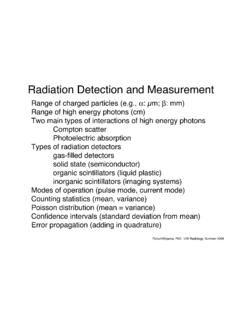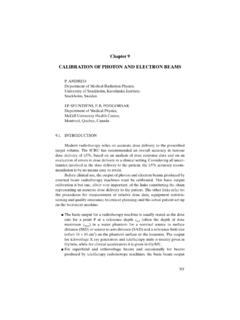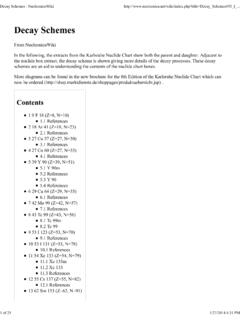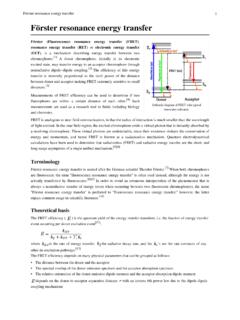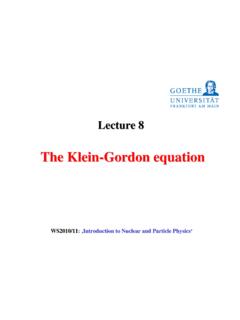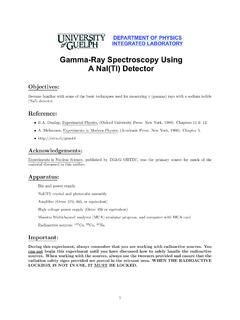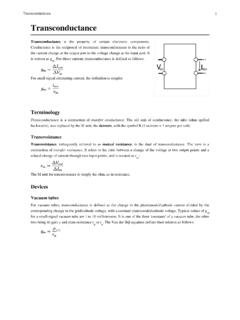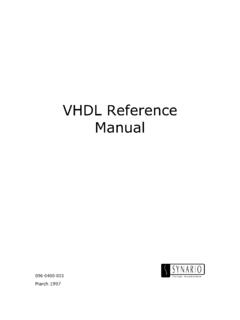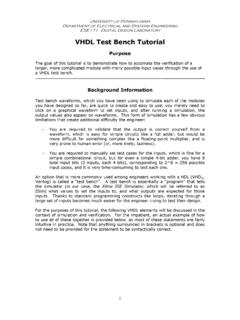Transcription of VHDL Syntax Reference
1 0 vhdl Syntax Reference By Prof. Taek M. Kwon EE Dept, University of Minnesota Duluth This summary is provided as a quick lookup resource for vhdl Syntax and code examples. Please click on the topic you are looking for to jump to the corresponding page. Contents 1. Bits, Vectors, Signals, Operators, Types .. 1 Bits and Vectors in Port .. 1 Signals .. 1 Constants .. 1 Relational Operators .. 1 Logical 2 Assignments .. 2 Concatenation, & .. 3 Type Conversion Chart .. 3 2. Concurrent Statements .. 4 Conditional Signal Assignment .. 4 Selected Signal Assignment.
2 5 3. Sequential Statements .. 5 Variables .. 5 If-then-else Statement .. 6 Case Statement .. 6 For 7 While Loop .. 8 Infinite Loop .. 8 Wait Statements .. 8 Finite State Machine (FSM) Implementation .. 9 1 1. Bits, Vectors, Signals, Operators, Types Bits and Vectors in Port Bits and vectors declared in port with direction. Example: port ( a : in std_logic; -- signal comes in to port a from outside b : out std_logic; -- signal is sent out to the port b c : inout std_logic; -- bidirectional port x : in std_logic_vector(7 downto 0); -- 8-bit input vector y : out std_logic_vector(7 downto 0) -- no ; for the last item ); Signals Signals are declared without direction.
3 Example: signal s1, s2 : std_logic; signal X, Y : std_logic_vector(31 downto 0); Constants Constants are useful for representing commonly-used values of specific types. Example: In the declaration area: constant init : std_logic_vector(3 downto 0) := 1100 ; signal sig_vec : std_logic_vector(3 downto 0); In the body: sig_vec <= init; Relational Operators Return a Boolean result and thus used in if or when clauses. = equal to: highest precedence /= not equal to < less than <= less than equal > greater than >= greater than equal: lowest precedence 2 Logical Operators Bit-by-bit logical operations.
4 Not example) (not a) highest precedence and or nand nor xor xnor lowest precedence Assignments <= signal assignment := variable assignment, signal initialization Example: signal q: std_logic_vector(3 downto 0); Multiple bits are enclosed using a pair of double quotations: q <= 1011 ; Hexadecimals are represented using X .. : q <= X B ; A single bit is enclosed using single quotations: q <= ( 1 , 0 , 1 , 1 ); You may use named association: q <= (3=> 1 , 2=> 0 , 1=> 1 , 0=> 1 ); Named association allows position independence, , you can write q <= (0=> 1 , 2=> 0 , 1=> 1 , 3=> 1 ); You may combine indices.
5 Q <= (3|1|0 => 1 , 2 => 0 ); Use the keyword others to simplify the expression. q <= (2=> 0 , others => 1 ); We frequently use others for initialization or setting bits. x <= 00000000 ; -- is same as x <= (others => 0 ); 3 Concatenation, & Example: signal a, b : std_logic_vector(7 downto 0) := 10111111 ; b <= a(7 downto 2) & 00 ; -- b contains 10111100 Type Conversion Chart signed(Numeric_std)unsigned(Numeric_std) std_logic_vector(Std_logic_1164)integer( Standard)signed()std_logic_vector()std_l ogic_vector()unsigned()to_integer()to_in teger()to_signed( ,len)to_unsigned( ,len)signed()unsigned() 4 2.
6 Concurrent Statements Any statement placed in architecture body is concurrent. Only one type of conditional statements is allowed as concurrent which are shown here. Conditional Signal Assignment Syntax : signal_name <= value_expr_1 when Boolean_expr_1 else value_expr_2 when Boolean_expr_2 else value_expr_3 when Boolean_expr_3 else .. value_expr_n; Example: 4-to-1 Mux z <= a when (s= 00 ) else b when (s= 01 ) else c when (s= 10 ) else d when (s= 11 ) else X ; A better way would be: z <= a when (s= 00 ) else b when (s= 01 ) else c when (s= 10 ) else d; 4-to-1 Muxadcbzs0s1 5 Selected Signal Assignment Syntax : with select_expression select signal_name <= value_expr_1 when choice_1, value_expr_2 when choice_2.
7 Value_expr_n when choice_n; Example: 4-to-1 Mux with s select z <= a when 00 , b when 01 , c when 10 , d when others; 3. Sequential Statements Variables Variables are objects used to store intermediate values between sequential vhdl statements. Variables are only allowed in processes, procedures and functions, and they are always local to those functions. When a value is assigned to a variable, := is used. Example: signal Grant, Select: std_logic; process(Rst, Clk) variable Q1, Q2, Q3: std_logic; begin if Rst= 1 then Q1 := 0 ; Q2 := 0 ; Q3 := 0 ; elsif (Clk= 1 and Clk event) then Q1 := Grant; Q2 := Select; Q3 := Q1 or Q2; end if; end process; 6 Note: Both signals and variables carry data from place to place.
8 However, you must always use signals to carry information between concurrent elements of your design. If-then-else Statement Syntax : if Boolean_expr_1 then sequential_statements; elsif Boolean_expr_2 then sequential_statements; elsif Boolean_expr_3 then .. else sequential statements; end if; Example: process ( a, b, m, n) begin if m = n then r <= a + b; elsif m > 0 then r <= a b; else r <= a + 1; end if; end; Case Statement Syntax : case sel is when choice_1 => sequential_statements; when choice_2 => sequential_statements.
9 When others => sequential_statements; end case; 7 Example: case sel is when 00 => r <= a + b; when 10 r <= a b; when others => r <= a + 1; end case; For Loop Syntax : for index in loop_range loop sequential statements; end loop; Example: constant MAX: integer := 8; signal a, b, y: std_logic_vector(MAX-1 downto 0); .. for i in (MAX-1) downto 0 loop y(i) <= a(i) xor b(i) end loop; 8 While Loop Syntax : loop_name: while (condition) loop ---repeated statements end loop loop_name; Example: while error_flag /= 1 and done /= 1 loop Clock <= not Clock; wait for CLK_PERIOD/2; end loop; Infinite Loop Syntax : loop_name: loop.
10 Exit when (condition) end loop loop_name; Example: loop Clock <= not Clock; wait for CLK_PERIOD/2; if done = 1 or error_flag = 1 then exit; end if; end loop; Wait Statements wait on signals; wait until Boolean_expr; wait for time_expr; 9 Finite State Machine (FSM) Implementation state0state11/00/11/00/1 Finite state machines in vhdl can be implemented by following a typical programming structure such as given below. It consists of two processes: one for combinational logic process that sets the next state and output, and a clock handling process that loads the next state to present state.
